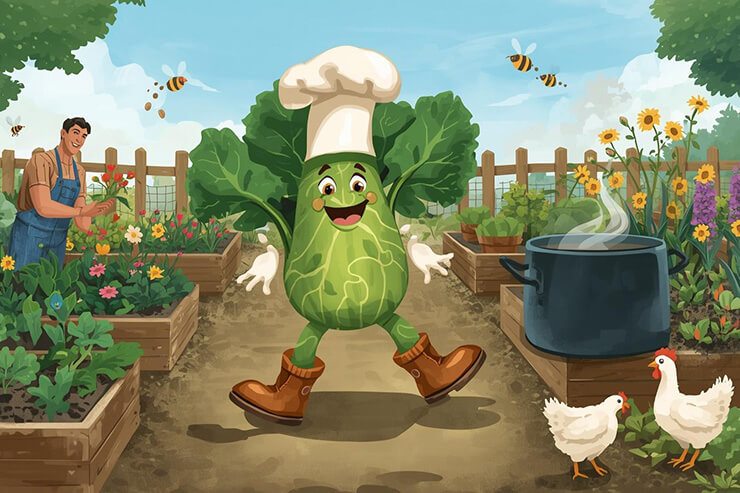Read by Michael Flamel

Once upon a thyme in the not-so-distant past, Americans were suspicious of anything green and curly that didn’t resemble iceberg lettuce or a dill pickle. Kale? Wasn’t that just fancy livestock fodder or garnish for a buffet table?
Not anymore.
Today, kale struts confidently through gardens and kitchens from coast to coast, holding its leafy head high as it gets massaged into salads, tossed into smoothies, crisped into chips, and sautéed with garlic in cast iron pans. But where did this veggie Cinderella come from, and why are we all growing it like we’re auditioning for a health-food fairytale?
Let’s rewind the compost bin a bit…
A Brief and Leafy History
Kale (Brassica oleracea var. acephala) is an ancient member of the cabbage family, cultivated as far back as 2,000 years ago in the Mediterranean and brought to Europe by Roman cultivators. It eventually made its way to America in the 17th century with English settlers—and quietly bided its time until its 21st-century glow-up.
Known for its hardiness, kale was a Winter staple in wartime Victory Gardens, and it remains one of the few vegetables that laughs in the face of frost. In fact, a little cold snap only sweetens its flavor. Talk about a drama queen with grit!
Why Kale Belongs in Your Garden (and Your Gut)
There’s a reason kale has become the green darling of nutritionists and Instagram influencers alike. It’s a superfood, yes—but also a super grower.
Health Perks of Kale:
- High in vitamins A, C, and K
- Loaded with antioxidants
- Great source of calcium and iron
- Low in calories, high in fiber
- Helps your body detox (because even livers need a spa day)
Garden Perks of Kale:
- Cold-hardy and easy to grow
- Pest-resistant (especially the curly types)
- Comes in glorious varieties like Red Russian, Lacinato (aka dinosaur kale), and Dwarf Blue Curled
- Produces multiple harvests from the same plant
How to Grow Kale (Without Losing Your Sanity)
In-Ground: Kale thrives in well-drained soil with full sun to partial shade. Direct sow seeds in early Spring or late Summer. Space seedlings about 12–18 inches apart, and they’ll reward you with months of leafy abundance.
Raised Beds: Perfect for better drainage and weed control. Mix in compost or organic matter, and plant as you would in-ground. Bonus: easier on your back when it’s harvest time!
Containers: Yes, kale grows happily in pots! Use a deep container (at least 12 inches) with good drainage and potting mix. Water it well and harvest outer leaves first. It’s a leafy little houseguest that doesn’t mind balconies or patios.
How to Kale-ify Your Weekly Menu
Now that you’ve grown it, what do you do with it? Here are just a few kale-icious ideas:
- Kale Chips: Toss with olive oil and sea salt, bake at 350°F for 10-15 minutes until crispy.
- Kale Caesar Salad: Massage with lemon juice and olive oil, then toss with Parmesan and whole grain croutons.
- Sautéed Kale: Sizzle with garlic and a splash of broth or white wine. Add chili flakes if you’re feeling bold.
- Kale & Sweet Potato Hash: Add to your Sunday brunch and thank us later.
- Kale in Smoothies: Just a leaf or two blended with bananas, berries, and yogurt. Green but great.
- Kale Soup: Add to white bean or sausage stew for a hearty cold-weather meal.
- Kale Pesto: Swap basil for kale, and toss with pasta or spread on flatbread.
You can even sneak kale into scrambled eggs, grain bowls, or lasagna—trust us, your future self will be impressed.
The Happily Ever After
So, there you have it: kale isn’t just a fad—it’s a flavorful, frost-kissed, nutrient-packed legend that’s here to stay. Whether you’re growing it in your backyard, your balcony, or your windowsill herb garden, kale is a gift that keeps on giving—leaf by curly, crunchy, glorious leaf.
Want to Grow the Best Kale Ever?
If you’re itching to start your own kale patch—or want even more inspiration for using it in your kitchen—check out our Complete Gardening Guide to Growing Kale. It’s packed with growing tips, troubleshooting tricks, and delightfully healthy recipes you’ll be proud to serve (and post).
Until next thyme, fellow gardeners—stay green, stay curious, and keep kale-ing it! ❖


 Previous
Previous

